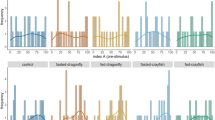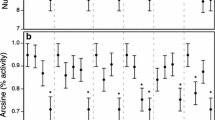Abstract
This study investigated how visual information about prey location and biomechanical constraints of the feeding apparatus influence the feeding behavior of the tomato frog, Dyscophus guineti. When feeding on prey at small azimuths (less than ± 40°), frogs aimed their heads toward the prey but did not aim their tongues relative to their heads. Frogs projected their tongues rapidly by transferring momentum from the lower jaw to the tongue. Storage and recovery of elastic energy by the mouth opening muscles amplified the velocities of mouth opening and tongue projection. This behavior can only occur when the lower jaw and tongue are aligned (i.e., within the range of motion of the neck). When feeding on prey at large azimuths (greater than ± 40°), frogs aimed both the head and tongue toward the prey and used a muscular hydrostatic mechanism to project the tongue. Hydrostatic elongation allows for frogs to capture prey at greater azimuthal locations. Because the tongue moves independently of the lower jaw, frogs can no longer take advantage of momentum transfer to amplify the speed of tongue projection. To feed on prey at different azimuthal locations, tomato frogs switch between alternative strategies to circumvent these biomechanical constraints.







Similar content being viewed by others
References
Anderson CW (1993) The modulation of feeding behavior in response to prey type in the frog Rana pipiens. J Exp Biol 179:1–12
Anderson CW, Nishikawa KC (1993) A prey-type dependent hypoglossal feedback system in the frog Rana pipiens. Brain Behav Evol 42:189–196
Anderson CW, Nishikawa KC (1996) The roles of visual and proprioceptive information during motor program choice in frogs. J Comp Physiol A 179:753–762
Deban SM (1997) Modulation of prey-capture behavior in the plethodontid salamander Ensatina echscholtzii. J Exp Biol 200:1951–1964
Ferry-Graham L (1998) Effects of prey size and mobility on prey capture kinematics in leopard sharks Triakis semifasciata. J Exp Biol 201:2433–2444
Lappin AK, German M (2005) Feeding behavior modulation in the leopard lizard (Gambelia wislizenii): effects of noxious versus innocuous prey. Zoology 108:287–295
Lappin AK, Monroy JA, Pilarski JQ, Zepnewski ED, Pierotti DJ, Nishikawa KC (2006) Storage and recovery of elastic potential energy powers ballistic prey capture in toads. J Exp Biol 2009:2535–2553
Liem K (1978) Modulatory multiplicity in the functional repertoire of the feeding mechanism in cichlid fishes. I. Piscivores. J Morphol 158:323–360
Mallett ES, Yamaguchi GT, Birch JM, Nishikawa KC (2001) Feeding motor patterns in anurans: insights from biomechanical modeling. Am Zool 41:1364–1374
Meyers JJ, O’Reilly JC, Monroy JA, Nishikawa KC (2004) Mechanism of tongue protrusion in microhylid frogs. J Exp Biol 207:21–31
Monroy JA (2000) Aiming during prey capture in microhylid frogs. Am Zool 40:6A
Mortin LI, Keifer J, Stein PSG (1985) Three forms of the scratch reflex in the spinal turtle: movement analyses. J Neurophysiol 53:1501–1516
Nishikawa KC (2000) Feeding in frogs. In: Schwenk K (ed) Feeding, form, function and evolution in tetrapod vertebrates. Academic, San Diego, pp 117–144
Nishikawa KC, Gans C (1996) Mechanisms of prey capture and narial closure in the marine toad, Bufo marinus. J Exp Biol 199:2511–2529
Nishikawa KC, Kier WM, Smith KK (1999) Morphology and mechanics of tongue movement in the African pig-nosed frog Hemisus marmoratum: a muscular hydrostatic model. J Exp Biol 202:771–780
Rice AN, Westneat MW (2005) Coordination of feeding, locomotor, and visual systems in parrotfishes (Teleostei: Labridae). J Exp Biol 208:3503–3518
Ritter DA, Nishikawa KC (1995) The kinematics and mechanism of prey capture in the African pig-nosed frog (Hemisus marmoratum): the description of a radically divergent anuran tongue. J Exp Biol 198:2025–2040
Schaerlaeken V, Meyers JJ, Herrel A (2007) Modulation of prey capture kinematics and the role of lingual sensory feedback in the lizard Pogona vitticeps. Zoology 110:127–138
Valdez CM, Nishikawa KC (1997) Sensory modulation and behavioral choice during feeding in the Australian frog, Cyclorana novaehollandiae. J Comp Physiol A 180:187–202
van Wassenberg S, Herrel A, Adriaens D, Aerts P (2006) Modulation and variability of prey capture kinematics in clariid catfishes. J Exp Zool 305:559–569
Wainwright P, Lauder G (1986) Feeding biology of sunfishes: pattern of variation in the feeding mechanism. Zool J Linn Soc 88:217–228
Walker JA (1998) Estimating velocities and accelerations of animal locomotion: a simulation experiment comparing numerical differentiation algorithms. J Exp Biol 201:981–985
Acknowledgments
This research was supported by grants IBN-0215438, IBN-0240349, IOS-0623791, and IIS-0827688 from the National Science Foundation. Helpful comments on earlier versions were provided by Jean Block, Carrie Carreno, Leslie Gilmore, Marci Hollenshead, A. Kristopher Lappin, Stan Lindstedt, Laura Krebs, Maureen Maloney, Erika Nowak, David Pierotti, and Eric Zepnewski. We also thank two anonymous reviewers for their insightful comments on previous versions of this manuscript. The experiments in this study were conducted in accordance with NIH publication No. 85-23, “Principles of laboratory animal care” and with the approval of the Institutional Animal Care and Use Committee at Northern Arizona University.
Author information
Authors and Affiliations
Corresponding author
Rights and permissions
About this article
Cite this article
Monroy, J.A., Nishikawa, K.C. Prey location, biomechanical constraints, and motor program choice during prey capture in the tomato frog, Dyscophus guineti . J Comp Physiol A 195, 843–852 (2009). https://doi.org/10.1007/s00359-009-0463-2
Received:
Revised:
Accepted:
Published:
Issue Date:
DOI: https://doi.org/10.1007/s00359-009-0463-2




